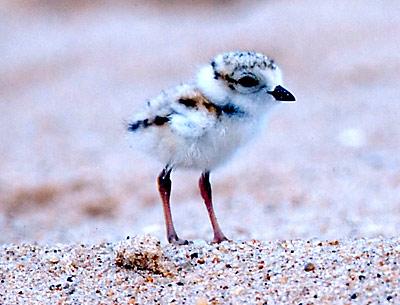Plover Population Plummets

Apparently it’s true. Piping plovers do taste like chicken, at least crows and foxes think so. Both predators have been on the increase for the past several years, foxes following an outbreak of mange that culled the population, and crows having recovered from the effects of the West Nile virus.
During a meeting of the East Hampton Town Trustees on Tuesday night, Stephen Lester, a trustee, asked if changes in United States Fish and Wildlife Service policy regarding the birds, changes that permitted people to spread towels and amble through areas sectioned off by snow fencing, were playing a negative role.
Lisa D’Andrea of the East Hampton Town Planning Department reported a dramatic drop in the number of the endangered and carefully protected shore bird hatchlings that lived long enough to fledge.
At the ocean beach by Georgica Pond, 12 chicks were hatched from three nests. All were taken by foxes. “Crows and foxes are back. A couple of exclosures were dug out,” Ms. D’Andrea said, referring to the wire cages often placed over nests to keep predators from them. “There was a nest at Lily Pond. A fox tried to dig it out, but didn’t succeed. We’re hoping they will survive. At the first plover nest that hatched at Lily Pond, chicks were gone in a couple of days. A fox got them,” Ms. D’Andrea said on Tuesday.
“Crows like the eggs and will go after young chicks. They are smart enough to know eggs are in the exclosures and if they keep watching, the hatchlings will eventually run out. We had a nest at Main Beach. We caught the crows sitting on the exclosure. The day they hatched, the crows were there. Parents saved two. It’s a learned behavior,” she said of the crows’ patience and cunning.
Ms. D’Andrea, who oversees the town’s plover protection efforts on approximately 18 miles of East Hampton coastline, said exclosures were used on a case by case basis.
“Sometimes exclosing them isn’t good. It announces they are there. Same with foxes. They see the structure. In some respects it’s like a bull’s-eye,” a target that counteracts the birds’ natural beach-colored, white, tan, and gray camouflage.
The rebounding fox population had been devastating for the endangered least tern breeding season. “We can’t exclose them. They’re fliers. Their defense is not so much camo, but numbers, but dive-bombing a fox doesn’t work.”
The town’s plover watcher said that after the mange devastated the fox population during the winter of 2000, plovers and least terns benefited from the predator’s absence. “There were a few of years of good plover activity.
In 2009, there were 46 plover pairs and 55 fledges. In 2006, one of the best seasons ever recorded, 56 plover pairs produced 94 fledges. In all, town managers watched over 31 pairs of plovers this season. As of Tuesday there were 24 fledges with a possible five more to come.
Piping plovers and least terns are protected by both state and federal law, and all efforts by town and county park and conservation agencies must follow guidelines adopted by the U.S. Fish and Wildlife Service. There are nesting areas on state land at Hicks Island, Napeague State Park, Goff Point, and Hither Hills State Park. Plovers nest on county parkland at Gin Beach in Montauk, Northwest Harbor, and Cedar Point Park in the Northwest section of East Hampton.
Mr. Lester’s question regarding any changes in Fish and Wildlife policy was answered yesterday during a phone interview with Steven Papa, a senior fish and wildlife biologist with the service. There have been no changes:
“Snow fencing is meant to keep vehicles out, but does not preclude beachgoers. The symbolic fencing [rope or string with flags] is the protected area. Nobody is allowed in those areas,” Mr. Papa said. Mr. Papa said he had put out a call to state and county park bird watchers for their fledgling numbers. They will be available soon.
